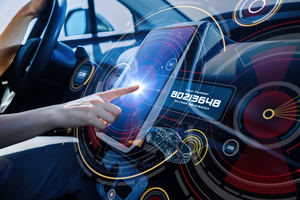Addressing storage challenges caused by centralised vehicle architecture

The connected vehicles of today are increasingly powerful machines, with the potential to become effectively, data centres on wheels.
The control units of modern vehicles serve a far greater purpose than just relaying information to the user they are connected to the internet, can drive entertainment hubs, and offer voice-activated controls, including the ability to make hands-free calls.
It is anticipated, says Christoph Mutz, senior product marketing manager, automotive, Western Digital, that fully centralised connected vehicle architectures will move a step closer to reality next year. However, with that comes some crucial challenges.
As a more connected city infrastructure is developed around us, the communications a vehicle will have with its surroundings dramatically increase (V2X) as will the volume of data produced. This will bring storage challenges as critical data is captured and relayed across the control unit and vehicle systems.
The development of a centralised architecture
As centralised connected vehicle architecture gets closer to becoming reality, there are a few considerations. Some of what were historically separate, function-specific Engine Control Units (ECUs) are now being designed to merge. In doing so, they form a more powerful system across the main control unit, enabling multiple tasks to be completed at a single point.
 The design of the architecture will be dependent on the requirements of the development team. For example, security related tasks for autonomous driving as well as in-car infotainment could all be covered by very few but powerful control units.
The design of the architecture will be dependent on the requirements of the development team. For example, security related tasks for autonomous driving as well as in-car infotainment could all be covered by very few but powerful control units.
These merged units or ‘Domain Control Units’ will have powerful processors and will require more memory than a stand-alone ECU, having storage capacities ranging from 32GB up to 1TB and beyond. The data requirements for infotainment are also set to increase due to 3D navigation maps with HD resolution and in some cases, music and video files.
The challenges that lie ahead
Cloud storage and edge data centres are a widely discussed topic and will serve a great purpose in the automotive industry as the proliferation of data each car produces continues to mount. However, relaying data to the cloud and the edge requires 5G connectivity, something that is currently limited in its rollout.
The by-the-second rate at which data is currently produced and the increasing power of the control units means on-board storage will be a necessity in the reliable capture and storage of vehicle data. Before it is able to be relayed to the cloud and edge servers, it will need to be stored in on-board vehicle storage drives to ensure safety and security of the data.

Christoph Mutz
Connected vehicles have the potential to become a data centre on wheels with the combination of elements comprising the centralised vehicle architecture. This will bring challenges not only for integration and virtualisation, but also for safety and security.
Currently there are several different architectures available, with many vehicle manufacturers creating their own. The question therefore becomes, what is the right architecture? To make this decision, the automakers, who are also the original equipment manufacturers (OEMs), in this case, and their tier 1 suppliers need to decide on what they want to prioritise, and storage cannot be an afterthought.
What will this mean for in-vehicle storage?
In general, this will open up new business models for OEMs. In particular, automated driving, which is currently being developed as a priority, will require storage space e.g. due to complex software, and the use of sensor fusion, several cameras and event data recording.
This is why data storage solutions will be a vital component to success of automated driving. Universal Flash Storage (UFS) will help to combat these challenges as a less complex storage system with reduced power consumption. As processors become increasingly powerful, the tasks they perform are more varied and intensive and vehicle innovation continues, utilising resilient and high-performance on-board storage will be key.
The author is Christoph Mutz, senior product marketing manager, automotive, Western Digital.
Comment on this article below or via Twitter @IoTGN
